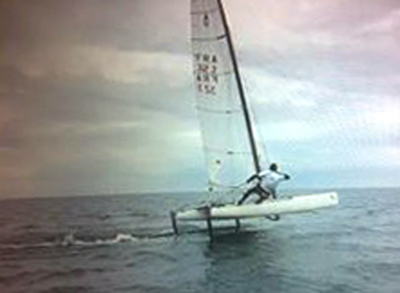Insight

Some thoughts following some recent on-the-water testing with a focus on handling. Specifically, we worked to gain data on how different foil configurations affect dynamic behaviour during turns in strong wind. The results confirmed observations we hear regularly from experienced Moth sailors, as well as those who race foiling multihulls such as the NACRA F20 […]
Imagineering Part 2

In Part 1 we looked at straight line sailing.We concluded that foils will always be a hindrance at very low speeds, but will give an advantage at higher speeds. More aggressive setups (read more foil area) are even worse at low speed but, since they allow earlier take-off, become superior ‘sooner’ (at a lower windspeed […]
Bravo

Congratulations to Sergio Vela, who placed third at the European Spring Championship, using retrofitted Paradox 2014 steering system.
Imagineering Part 1

In response to questions about where catamaran foil design may go in the future, especially if rule constraints are relaxed, here are some thoughts on the incentives driving design choices. If our goal is fastest time around a windward/leeward course, then the considerations are: – VMG upwind. – VMG downwind. – Control at low speed, […]
2015 Paradox

First Public Introduction of our All New Version 3 A Class Catamaran Concept – Speed, stability, easy to tune for different conditions, value, elegant engineering. – Benefiting from three years of structured testing, data collection and validation. – Developed in close collaboration with Glenn Ashby. – Built in Australia to aerospace standards. Hull Shape […]
Farewell 2014

Some images looking back on a year of regrouping, transition, and growth: Production L rudders, proven at the A Class Catamaran Worlds Mould for experimental T rudder elevator with junction bulb. Part of extensive R&D work on appendages Rudder gudgeon assembly with ‘between races’ rake adjustment Experimental gudgeons with ‘on the fly’ rake adjustment via […]
Choices

We have received many questions regarding the differences between ‘active’ and ‘passive’ foil systems for full foiling. So here is a look at the principles with respect to performance. Active An active system consists of a foil with variable camber or variable angle of incidence controlled by a sensor that measures heave position (ride height). […]
Checking In
Click here to read a Q&A Session with Martin Vanzulli who is doing a great job of keeping the A Class website up to date as well as running the Catsailingnews blog. The interview covers our V3 Paradox A Class design (nearing production) as well as our ongoing foil R&D work. The final questions are […]
Higher Learning
Earlier today two teams from the University of NSW presented results of an inquiry into theoretical hydrofoil stability and performance. The teams undertook to assess three candidate foil types on an A Class catamaran and investigate relative characteristics of lift, drag and change in lift with ride height/leeway. A more detailed report is being prepared, […]
Working the Angles
Our Paradox Version 3 A Class cat platform design is complete and tooling is underway. The foil housing arrangement in the new boat is designed to accommodate virtually any shape with full interchangeability of parts using a new version of our proven system of hull and deck bearings. Now focus is on foil design. The […]